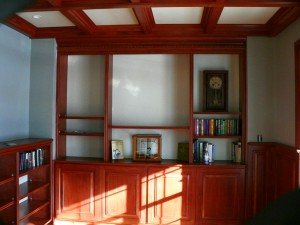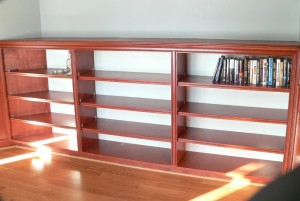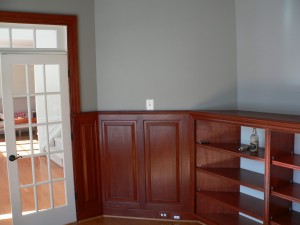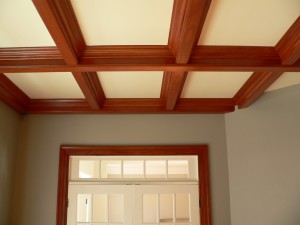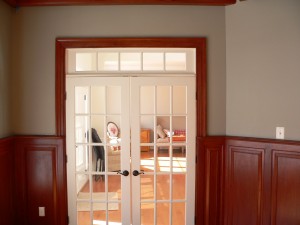African Mahogany Library

Library or study was a blank slate left in the a painted drywall and molding trim state by the building contractor. The room was 12 feet 2.5 inches wide and 14 feet 7 inches long. It had a 45 degree wall intersection on the long wall so effectively you had two 12 feet wide walls that were not broken up with doors or windows and 4 feet wide wall (wall at 45 degree intersection). The 10 feet ceiling height was the other room’s design feature affecting the bookcase design.
The “she who must be obeyed” (SWMBO) half of the owner team wanted a coffer ceiling and wainscoat – so guess what was included in the library design work up. Should the library be a place dedicated to books storage or focus on the display arts and objects of interest lead the discussion of design functionality. The art objects won the debate and it was decided that one wall would have a casework height that matched the wainscoating.
The winning debate points
- The ability to display more items collected over the years trumped book storage – and many books were paperback so public display was not important. Using doors on the bottom portion of the floor to ceiling case would create a private storage area for the paperback and other uninteresting items.
- Looking into the future, people would place less value on the ability to store books because of electronic storage and retrieval – people will not value the need to store dead trees
- Floor to ceiling cases on two walls would compress the room visually and limit the artwork display space.
The big final design element was a natural wood finish preferably Mahogany as the base wood. Stock availability and COST lead to a compromise of using African Mahogany – wood that is not related to Central and South American “genuine” Mahogany – that has a very similar appearance if stained to the burgundy brown that most people associate with Mahogany furniture. Use of natural wood instead of a painted surface meant that the construction technique is similar to finer furniture that limits exposed fasteners.
Other design considerations:
- Use painted walls behind the case work and in the ceiling panels between the coffer beams – dark burgundy wood panels would make the room dark and visually compress the space. A Sherwin Williams off white (Sage) was used to highlight the dark wood and Benjamin Moore Sabre Gray walls
- a shelf width of 16 inches instead of a more traditional 12 inch shelf – a “coffee table book” will not fit on a 12 standard shelf. Since displaying pottery and other objects were part of the design consideration, the wider shelf size provided more flexible spaces. Adding two inches to the width of the enclosed base cabinet provided a usable transition to the floor-to-ceiling case
- perpendicular intersection of the casework – the what to do with the corner dilemma was addressed by building symmetrical 16 inch wide by 18 inch deep columns on each side of the floor to ceiling case work. These columns provided a convenient electrical chase for cabinet lighting circuit and correction of less than plumb and square corners left by the building contractor. By using a column offset, the shorter case work wall height is not dictated by the door size of the floor to ceiling enclosed case.
- Use a raised panel design to give the doors and wainscoat a shadow dimension.
- Use a classic 9:7 ratio to maintain the visual perspective of height. For a ten foot wall – minus the baseboard 4.5 inches and the coffer beam 4.5 inches = 111 inches of visual space =~7 inches module = 49 (7*7) inches for the cabinet and wainscoat (plus 4.5 for baseboard) = 53.5 inches for the floor to the top of the wainscoat/short case. The wall space above this line would be = 63 (9*7) plus 4.5 coffer = 67.5 inches.
- By adding a 7 inch molding element above floor-to-ceiling case, another classic 3 over 2 proportional relationship developed for open space above the enclosed cabinets.
People often ask how long does something like that takes to build and how much materials so I kept a timecard
- Milling – 76 hours – includes stock preparation, creation of custom molding elements and project design
- Finishing – 99 hours – includes surface preparation, staining, varnishing and wall prep (painting and surface finish)
- Installation – 152 hours – assembly and installation of components, moving electrical circuits and installing lights and room clean up
The room preparation and coffer ceiling installation took about 115 hours. The majority of this time was the installation of the crown molding detail. The coffer was the equivalent of installing 12 rooms of crown molding.
Materials
- about 200 board feet of 1 inch stock African Mahogany,
- about 25 board feet of 2 inch stock African Mahogany
- 200 feet of crown molding African Mahogany
- 40 feet of window case stock African Mahogany
- 5 sheets of cabinet grade 3/4 inch plywood (Sandeply)
- 8 sheets of cabinet grade 1/2 inch plywood (Sandeply)
- 2.5 sheets of African Mahogany veneer 1/2 plywood
- 1 sheet of 1/4 Luana plywood
- 5 quarts wood stain
- 2 gallons of waterborne varnish
- gallon of paint for the ceiling, inside the base cabinets, walls behind the case work, nominal gallon of paint for walls above short case work and wainscoat
- countless sheets of sandpaper and numerous assortment of screws, pin nails, pneumatic staples, quart of glue and 8 tubes of adhesive caulking.
Click on any image to enlarge and use the “back arrow” to return to this page
After 326 hours it is done
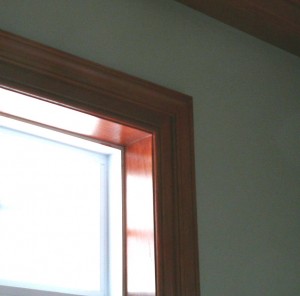
The molding window surround used a standard 2.5 inches case molding applied over a bead board (4.5 inches wide). A custom milled 1/8 inch thick veneer board was applied to the existed extension jam to finish the transformation.



